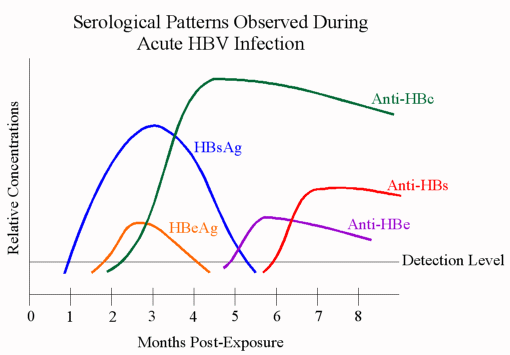
|
|
|||
| DIAGNOSIS Clinical Phases During Acute Infection Acute viral hepatitis infection can be broken into four stages: i) incubation period, which is the time between initial viral entry into the cell to first day of symptoms; ii) prodromal or pre-icteric period; iii) the icteric phase; and iv) recovery. Symptoms during the onset of acute hepatitis B viral infection vary, depending on the individual. Many children and some adults infected with the virus never show any discernible symptoms. However, most infected individuals experience a certain level of jaundice which tends to develop soon after the virus can be detected in the blood. Often, jaundice is preceded by mild fevers, fatigue, malaise, loss of appetite, and sometimes nausea and vomiting. During the icteric or blood-borne phase, an infected individual's urine tends to have a dark, golden-brown appearance. This is often followed by the lightening of the stool as well as the yellowing of the skin, typically seen in jaundice. Jaundice is considered clinically apparent once total bilirubin levels are greater than 2-4mg/dl Signs
of Liver Trouble
If one suspects one has a liver condition, it is highly recommended that one sees a doctor and be tested to determine whether one's concerns are well-founded. Early detection may help simplify treatment. Blood
Tests for Diagnosing Hepatitis B |
|||
| Presence of HBsAg | Presence of Anti-HBs | Presence of Anti-HBc | Interpretation of Assay Results |
| Positive | Negative | Negative | These results are characteristic of early acute HBV infection. |
| Positive | Positive or Negative | Positive | These results suggest either acute or chronic HBV infection which may be differentiated with respect to IgM anti-HBc. |
| Negative | Positive | Positive | These results are characteristic of previous HBV infection and current immunity to the virus. |
| Negative | Negative | Positive | These results do not have a clear interpretation. They could be due to HBV infection in the remote past, low-level HBV infection, or false-positive/ non-specific reactions. If present, anti-HBs help validate anti-HBc reactivity. |
| Negative | Negative | Negative | These results suggest that liver toxicity is due to some other agent other than HBV. |
| Negative | Positive | Negative | These results are typical of a vaccinated individual. |
| Reference
Ranges in Clinical Biochemistry Tests These are average ranges and times I have managed to compile, but may not exactly match those used by all medical centres. AST (Aspartate Aminotransferase)
or SGOT (Serum Glutamic-Oxalocetic Transaminase): 5-54 U/L | This
enzyme is found mainly in heart, kidney, liver, muscle, and pancreatic
tissues. Tissue damage releases this enzyme and elevated levels can be
detected in the blood. Vitamin B deficiency and pregnancy may actually
decrease levels of this enzyme found in the blood. |

Hollinger, F.B. and Dienstag, J.L. 1995. Hepatitis B and D Viruses. In: Murray, P.R., Baron, E.J., Pfaller, M.A., Tenover, F.C. and Yolken, R.H. (eds.) Manual of Clinical Microbiology, 6th ed. Washington, D.C.: ASM Press; pp. 1033-1049.
What's
New? | Introduction/History
| Epidemiology | Pathogenesis
Diagnosis | Clinical Types
| Treatments | Prevention